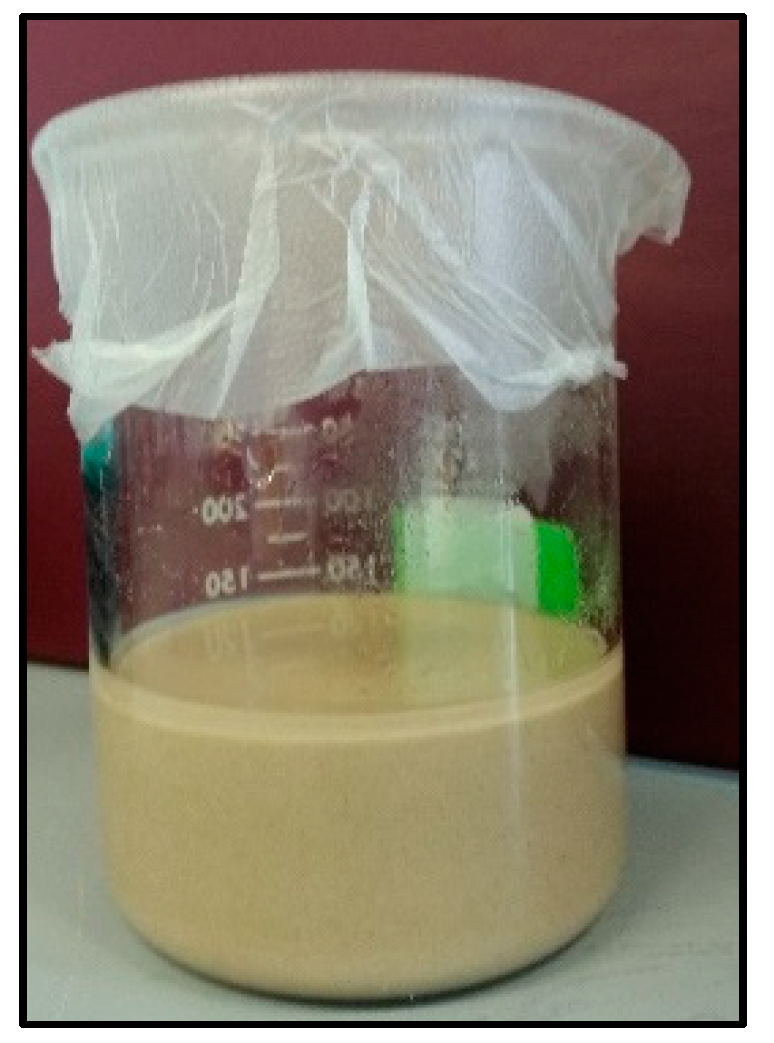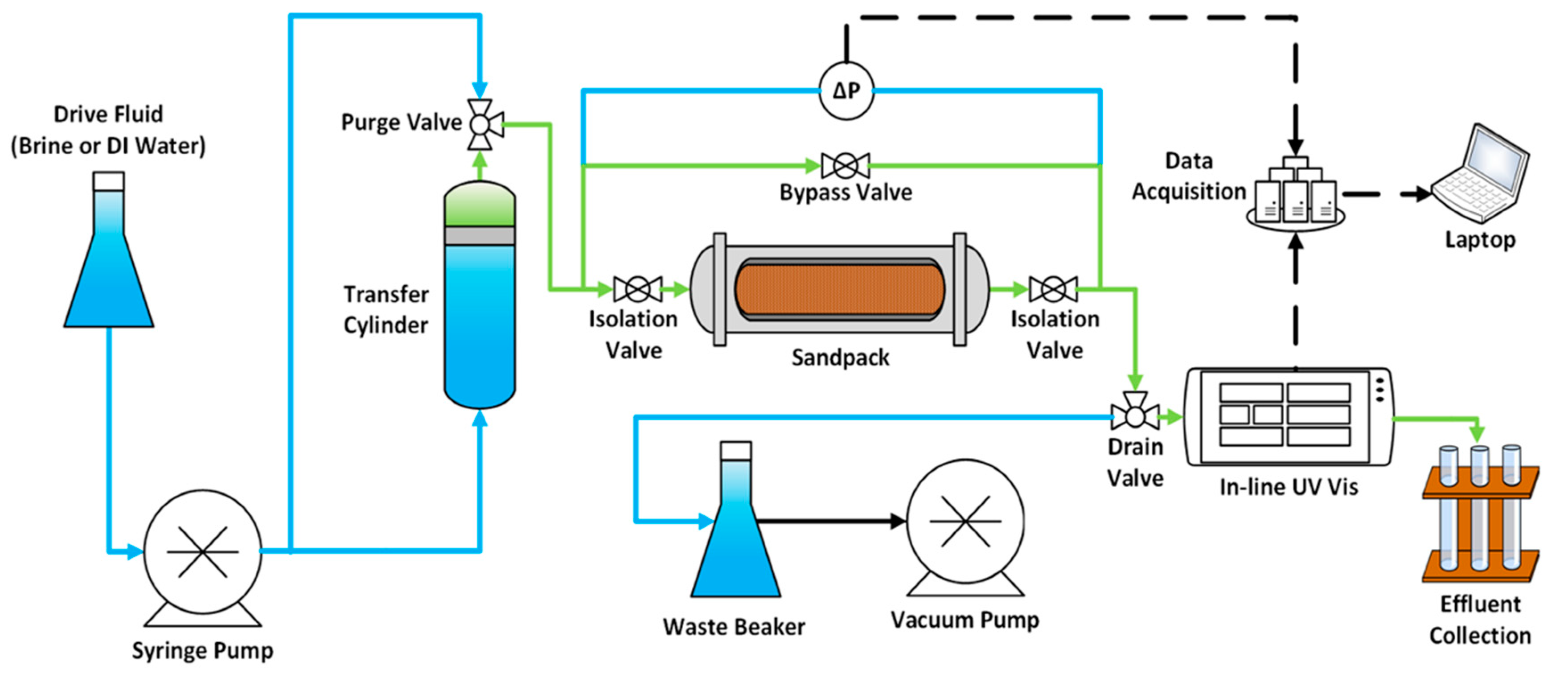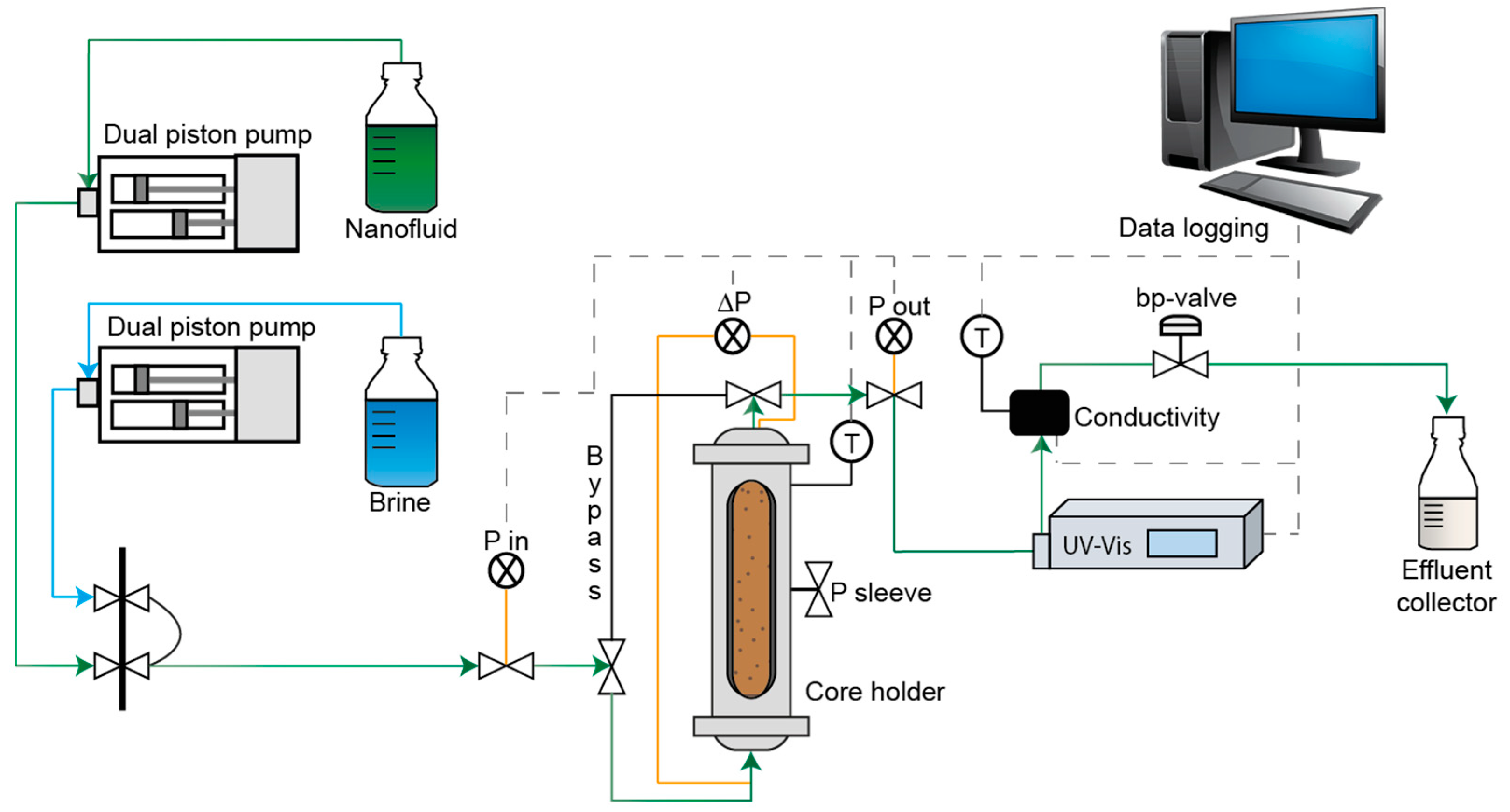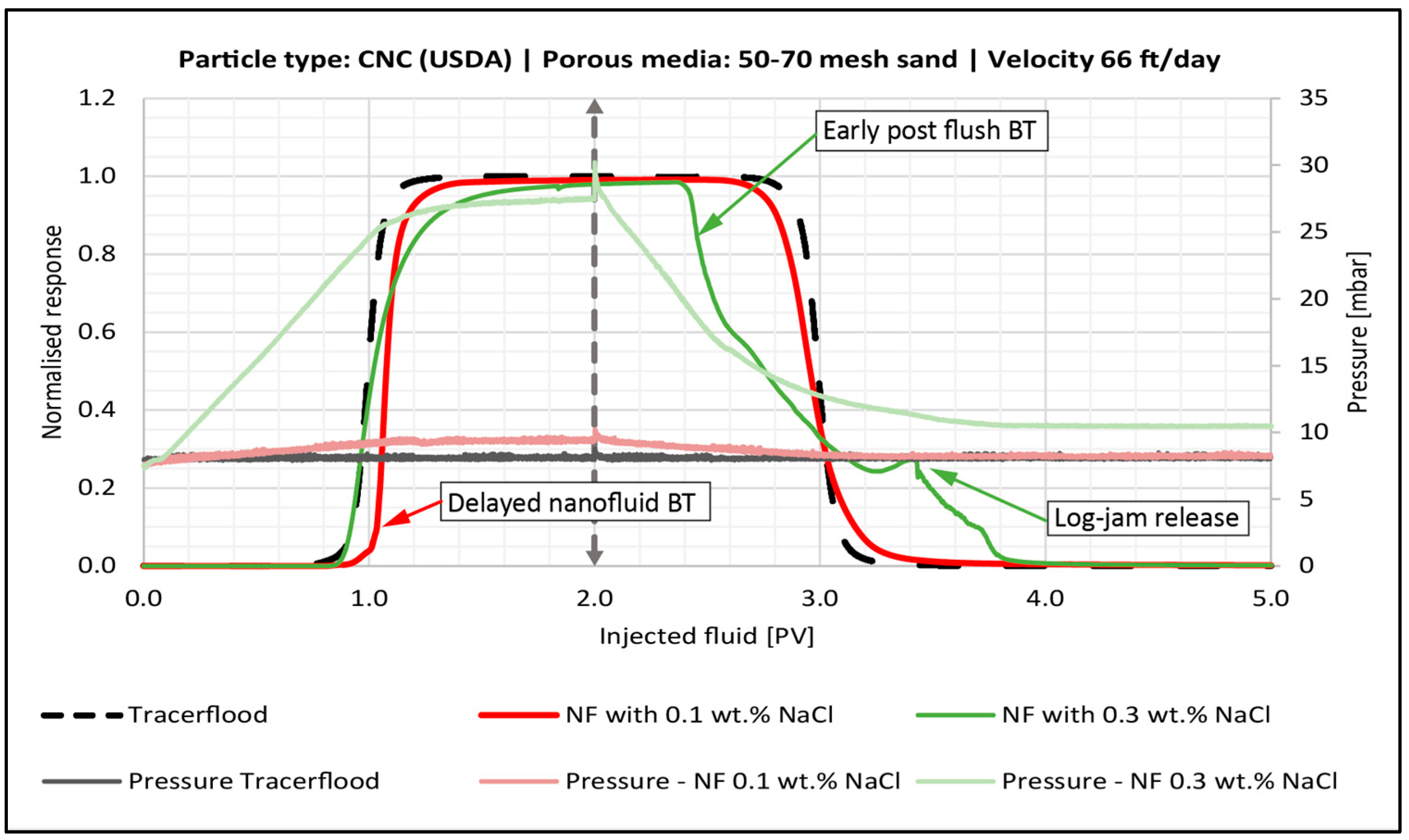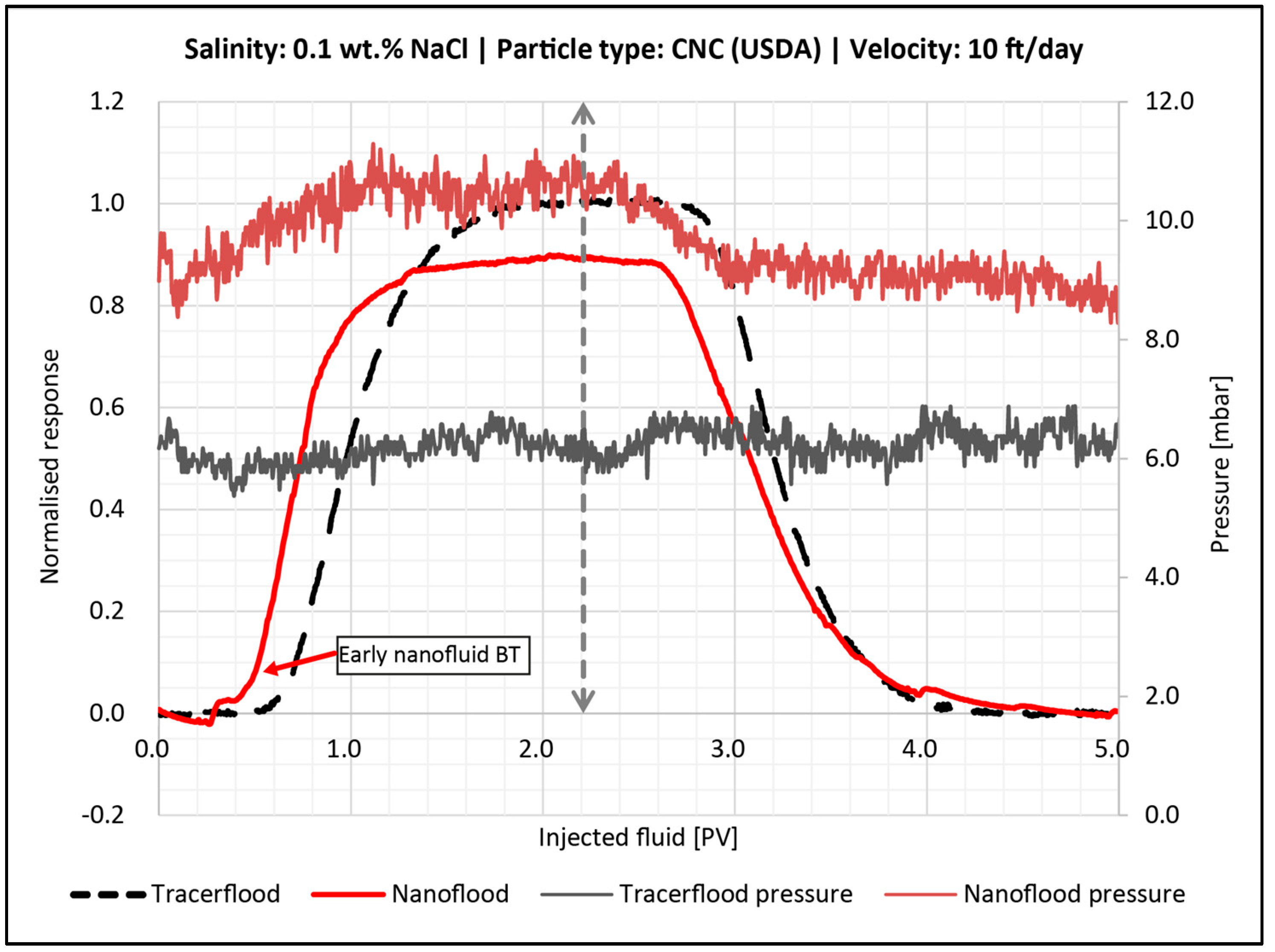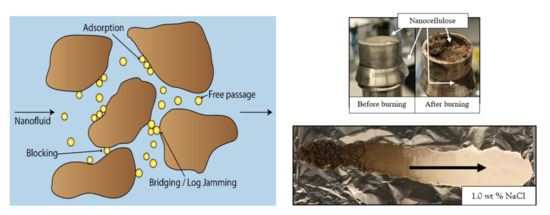1. Introduction
Chemical flooding with polymers is considered one of the most promising Enhanced Oil Recovery (EOR) methods and has been researched for over 40 years. When polymer flooding is applied to a reservoir, water-soluble polymers are added to the water prior to injection. The main objective is to improve the macroscopic displacement efficiency by increasing the viscosity of the aqueous phase. A higher viscosity of water results in a favorable mobility ratio, which reduces viscous fingering effects and changes the flow pattern in the reservoir [
1,
2,
3].
Today, two main polymers are used commercially; the polysaccharide biopolymer xanthan gum and the synthetic polymer hydrolyzed polyacrylamide (HPAM) [
4]. From reported field data for polymer floods, HPAM has been used in about 95% of the projects [
5]. China is the leading country in implementation of polymer flooding projects, and several major Chinese oil fields, such as Daqing and Shengli, have applied it as a successful EOR-technique. HPAM is the commonly used polymer in their fields, and from good quality reservoirs it has been reported that the incremental oil recovery has increased by as much as 14% of the original oil in place (OOIP) [
5]. Despite these good results, synthetic polymers have limitations. They are sensitive to high reservoir temperatures and susceptible to shear degradation. Even though they develop good viscosities in fresh water, they have poor thickening powers in high salinity. Biopolymers, on the other hand, exhibit great thickening abilities in high salinity water and have good shear stability. However, they are susceptible to microbial degradation in the reservoir, have poor thermal stability and can plug formations. Another drawback with biopolymers is that they have a higher cost than synthetic polymers [
2,
6]. Many of the polymers used today are considered to be toxic; it is therefore of high importance to find EOR-chemicals that are biodegradable after use.
This paper focuses on the use of novel nanoparticles as an alternative to polymer flooding. These particles are from the nanocellulose family that comprises of cellulosic materials in nanoscale. Cellulose (
Figure 1) is a linear polysaccharide polymer that is comprised of many glucose monosaccharide units. There are three free hydroxyl (–OH) groups in each glucose unit in a cellulose chain. These groups govern the important physical properties of cellulose [
7]. Cellulose is one of the most important biopolymers on Earth, and it is an abundant resource, as it is the structural component in the cell walls of plants [
7]. Wood and cotton are the two most common cellulosic sources.
Nanoscale cellulose particles may be classified into three main subcategories: bacterial nanocellulose (BNC), cellulose nanofibers (CNF) and cellulose nanocrystals (CNC) [
8]. Only the last category is considered in this paper. Cellulose fibers can be converted into CNC by chemical treatment. A cellulose fiber consists of highly ordered (crystalline) and disordered (amorphous) regions (
Figure 2). The amorphous regions are removed through acid hydrolysis and only crystalline parts remains [
8]. The crystalline parts are in the nanometer size range in all dimensions. CNC from wood is typically ranging from 3 to 5 nm in width and 100 to 200 nm in length [
9].
Nanocellulose is an emerging new type of nanoparticle in the petroleum industry and little research exists on its applications for EOR. Preliminary results from oil recovery core floods using CNC particles dispersed in low salinity brine show that the particles have potential as an additive during waterflooding [
10]. Experiments were conducted at 60 °C and 90 °C, where the CNC dispersion was injected after water flooding. There was no significant EOR effect during the 60 °C test, but at 90 °C the CNC particles showed a tertiary EOR effect of 3.4% OOIP. A pressure increase with accompanying pressure fluctuations was observed during the CNC injections. Thus, introduction of CNC particles into the porous media affects the fluid flow within the pores. CNC particles could therefore improve microscopic and macroscopic sweep efficiencies through flow diversion [
10].
Wei et al. [
11] conducted EOR experiments on two types of modified cellulose nanofibrils with different charge densities. Their work showed promising results for nanocellulose as a potential EOR agent. The two types of nanocellulose were injected as a tertiary recovery technique through a heterogeneous micromodel. Improvement of macroscopic sweep efficiency was seen when the nanoparticles were introduced to the system. The nanocellulose with highest charge density had the greatest effect on oil recovery. Interfacial tension (IFT) measurements showed that the particles resulted in a decrease of the dynamic interfacial tension (oil/nanofluid) to the order of 10
−1 mN/m. A low IFT is a favorable property for an EOR agent. From a microscopic view, it was concluded that the particle with the highest surface charge resulted in a more efficient displacement of the trapped oil in the small pores. Due to the surface activity of the nanofluids, the residual oil was emulsified and entrained in the aqueous phase [
11].
Fundamental research concerning particle stability in brine and single-phase flow experiments has also been reported in literature. Molnes et al. [
12] established that stable dispersions of CNC were obtained in 1000 ppm NaCl brines. The tested nanocellulose concentrations ranged from 0.5–2.0 wt. %. All dispersions remained stable and the stability was verified through zeta-potential measurements. Furthermore, the CNC dispersion was injectable through a sandstone core. Nevertheless, there were some indications that some of the CNC particles were trapped inside the pore matrix, which is a common phenomenon when dealing with polymers [
12]. Another study performed by Molnes et al. [
10] tested injection of CNC in Berea sandstone at different temperatures (60, 90 and 120 °C). These results also showed that the particles traversed the core, but some of the particles were retained at the core inlet [
10].
The aim of the present study was to continue the work on single-phase flow, and identify the main retention mechanism affecting the transport of nanocellulose through porous media. Nanocellulose are not spherical, but rod-shaped particles with an aspect ratio of order of 100:3, which adds a new element of complexity to their flow behavior. During nanoparticle flow through porous media, there are four potential transport outcomes—adsorption, blocking, bridging (log-jamming) or free passage (
Figure 3).
Adsorption can occur if the nanoparticle size is much smaller than the pore size and there exists physiochemical interaction between the particle and the pore wall. The particles will then adhere to the pore wall, which could also lead to a wettability change, in addition to loss of matter. This adsorption can be reversible or irreversible.
Blocking can take place if the particle is much larger than the pore throat. If blocking is severe enough, it can result in internal filter cake formation or face plugging. This may be an attractive property in a drilling fluid, as filter cake formation would help minimize fluid exchange with the formation during drilling operations.
Bridging or log-jamming of the pore throat arises when two or more particles with sizes slightly smaller than a pore throat arrive at the pore throat together. Log-jamming may improve sweep efficiency during water flooding. Formation of log-jams in the high permeability channels can divert the flow of subsequent fluids into the unswept low permeability pores, thereby increasing oil recovery.
Free passage happens if the pore throat is large enough for nanoparticles to easily move through [
13]. Free passage allows for long-distance transport in the subsurface and is the desired outcome if nanocellulose is to be developed into an alternative to polymer flooding technology.
In general, two opposing effects govern polymer propagation through porous media: retention and inaccessible pore volume (IPV). IPV accelerates polymer propagation, while retention retards it [
14]. Polymer molecules can be large compared to some of the pores in a rock. Thus, polymers will not have the ability to flow through all the pore space that is contacted by the brine, giving rise to the concept of inaccessible pore volume in the porous media [
15].
Retention is a collective term that involves adsorption and mechanical entrapment (blocking or log-jam). It is an important concern for the EOR application of nanocellulose, as high retention can delay oil displacement and recovery, and will also induce a higher cost as more particles are needed to obtain the desired concentration and viscosity of the injection fluid [
14]. Factors influencing polymer retention in porous media include polymer chemistry and composition, formation properties and flow rate. Variables within formation properties include permeability of the rock, clay content, mineralogy, temperature, salinity and pH of the brine. From the formation properties, permeability and clay content seem to have the most effect on retention. Clay has a high specific surface area, thus the retention tends to increase in the presence of clay. Retention also tends to increase for polymers as permeability decreases [
1,
14].
Polymer retention levels reported in literature range from 9–700 μg/g [
15]. According to Lake [
5], a good EOR polymer should have retention less than 20 μg/g [
5]. If polymer retention values are higher than 200 μg/g, it could have a serious impact on oil displacements rates and the economics of polymer flooding [
14]. A study performed by Zhang et al. [
16] investigated retention of HPAM through Dundee sandstone (~400 mD) and sandpacks (4.7 D–5.5 D). Two core floods were performed, which resulted in retention values of 16.1 μg/g and 56.5 μg/g. The floodings done in the sandpacks had less retention, ranging from 4.6 to 27.8 μg/g [
16]. Martin et al. [
17] studied both HPAM and xanthan retention in Berea sandstone cores (350–550 mD) using two different brine concentrations. Seven commercial HPAM polymers exhibited retention values of 15.5 ± 3 μg/g and 25.1 ± 2.1 μg/g in 0.1 wt. % NaCl and 2 wt. % NaCl, respectively. Under the same conditions, three commercial xanthan polymers showed retention values of 7.5 ± 1 μg/g in 0.1 wt. % NaCl, and 11.6 ± 3 μg/g for 2 wt. % NaCl [
14,
17].
Lotsch et al. [
18] measured retention of xanthan in Bentheim sandstones (1600–2000 mD), and got values ranging from 70 to 120 μg/g [
18]. This is similar to the values Huh et al. [
19] got for injecting xanthan in Berea sandstone cores. They conducted one single-phase experiment where retention was 31 μg/g, and five experiments with two-phase flow, where retention ranged from 49 to 72 μg/g. In their studies they concluded that retention increased with increasing polymer concentration, and it also increased somewhat with the flow velocity [
19]. In contrast, sandpack floods with silica nanoparticles showed less retention at higher injection rates, thus implying that nanoparticle retention was not caused by size exclusion, but by physiochemical interactions. In the same study, they also investigated how retention was affected by silica nanoparticle concentration and clay content. They conducted 18 experiments in total and got retention values that ranged from 0.25 to 11 mg/g [
20]. Compared to polymer flooding, 11 mg/g is almost 16 times higher than the highest value reported for polymer retention. As nanocellulose is derived from a polymer, but with size in the nanoscale, it is important to determine which factors influence its transport during flow in porous media.




